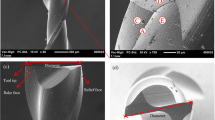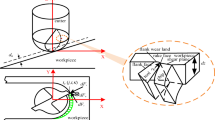Abstract
Tool wear is thus of great importance to understand and quantitatively predict tool life. In this paper, a tool wear model for ball end milling cutter is established with considering the joint effect of machining conditions for predicting tool wear. The modelling process of tool wear is given and discussed according to the specific conditions. In order to determine coefficients of the established tool wear model a new tool wear estimation method based on shape mapping is used to measure tool wear which is suitable to prepare tool wear data for the established model. So tool wear for each experiment can be obtained from the tool wear estimation method and be used to fit the proposed tool wear model by using multiple linear regression method. Experimental work and validation are performed on five-axis high speed machining centre for cemented carbide cutting tool milling stainless steel. Experimental results indicate that tool wear can be predicted within 10 % on an average using the established tool wear model and the established tool wear model is suitable to predict tool wear at certain range of cutting conditions for milling operation.







Similar content being viewed by others
References
Shi, D., Gindy, N.N.: Tool wear predictive model based on least squares support vector machines. Mech. Syst. Signal Process. 21(4), 1799–1814 (2007)
Kwon, Y., Fischer, G.W.: A novel approach to quantifying tool wear and tool life measurements for optimal tool management. Int. J. Mach. Tools Manuf. 43, 359–368 (2003)
Oraby, S.E., Hayhurst, D.R.: Tool life determination based on the measurement of wear and tool force ratio variation. Int. J. Mach. Tools Manuf. 44, 1261–1269 (2004)
Richetti, A., Machado, A.R., Da Silva, M.B., Ezugwu, E.O., Bonney, J.: Influence of the number of inserts for tool life evaluation in face milling of steels. Int. J. Mach. Tools Manuf. 44, 695–700 (2004)
Bhattacharyya, P., Sengupta, D., Mukhopadhyay, S.: Cutting force-based real-time estimation of tool wear in face milling using a combination of signal processing techniques. Mech. Syst. Signal Process. 21(6), 2665–2683 (2007)
Wang, H., Shao, H., Chen, M.: On-line tool breakage monitoring in turning. J. Mater. Process. Technol. 139(1–3), 237–242 (2003)
Kious, M., Boudraa, M., Ouahabi, A.: Influence of machining cycle of horizontal milling on the quality of cutting force measurement for the cutting tool wear monitoring. Prod. Eng. 2(4), 443–449 (2008)
Li, X.: A brief review: acoustic emission method for tool wear monitoring during turning. Int. J. Mach. Tools Manuf. 42(2), 157–165 (2002)
Liu, Q., Altintas, Y.: Online monitoring of flank wear in turning with multi layered feed forward neural-network. Int. J. Mach. Tools Manuf. 39, 1945–1959 (1999)
Chen, J.C., Chen, J.C.: An artificial-neural-networks-based in-process tool wear prediction system in milling operations. Int. J. Adv. Manuf. Technol. 25(5–6), 427–434 (2005)
Chien, W.-T.: The investigation on the prediction of tool wear and the determination of optimum cutting conditions in machining 17-4PH stainless steel. J. Mater. Process. Technol. 140(1–3), 340–345 (2003)
Jurkovic, J., Korosec, M., Kopac, J.: New approach in tool wear measuring technique using CCD vision system. Int. J. Mach. Tools Manuf. 45(9), 1023–1030 (2005)
Castejon, M., Alegre, E., Barreiro, J., Hernandez, L.K.: On-line tool wear monitoring using geometric descriptors from digital images. Int. J. Mach. Manuf. 47(12–13), 1847–1853 (2007)
Liu, Q.: Partial least-squares regressive analysis and modeling for tool wear. J. Beijing Univ. Aeronaut. Astronaut. 26(4), 457–460 (2000)
Xie, L., Zheng, D., Schmidt, C., Schmidt, J.: Study on prediction of tool wear in turning operation based on differential wear rate model. Tool Eng. 41(5), 17–21 (2007)
Ozel, T., Karpat, Y., Figueira, L.: Modeling of surface finish tool flank wear in turning of AISI D2 steel with ceramic wiper inserts. J. Mater. Process. Technol. 189(1–3), 192–198 (2007)
Koren, Y.: Flank wear model of cutting tools using control theory. J. Eng. Ind. Trans. ASME 100(1), 103–109 (1978)
Zhang, C., Liu, X., Fang, J., Zhou, L.: A new tool wear estimation method based on shape mapping in the milling process. Int. J. Adv. Manuf. Technol. 53(1–4), 121–130 (2011)
Acknowledgments
This research was supported by the Natural Science Foundation of China (NSFC) under Grant no. 50805078. The authors want to express their sincere gratitude to the Selection Committee for the Natural Science Foundation of China Grant and for the financial support that made this research possible.
Author information
Authors and Affiliations
Corresponding author
Additional information
This study was supported by the Natural Science Foundation of China (Grant No. 50805078)
Rights and permissions
About this article
Cite this article
Zhang, C., Zhou, L. Modeling of tool wear for ball end milling cutter based on shape mapping. Int J Interact Des Manuf 7, 171–181 (2013). https://doi.org/10.1007/s12008-012-0176-6
Received:
Accepted:
Published:
Issue Date:
DOI: https://doi.org/10.1007/s12008-012-0176-6




